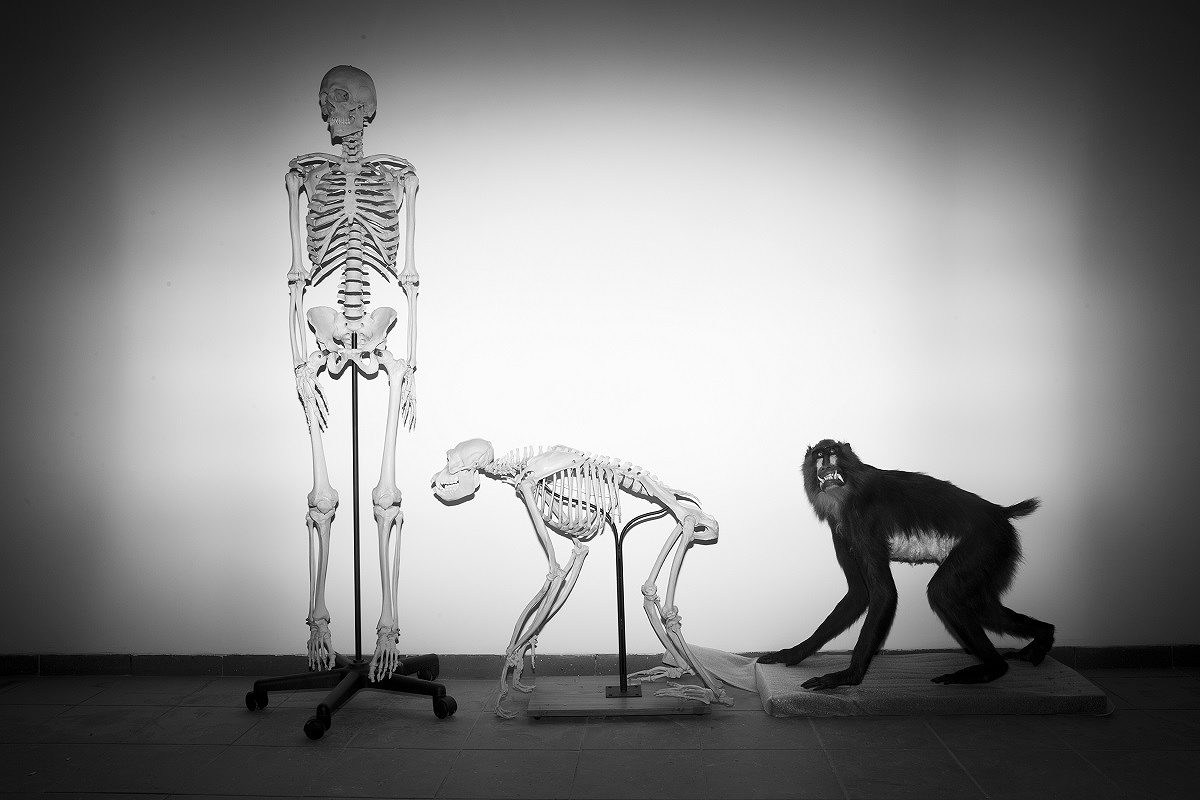
Skeletons of a human and a monkey await installation next to a taxidermy mandrill at the Steinhardt Museum of Natural History in Tel Aviv in February 2018.
16:57 JST, March 6, 2024
WASHINGTON (AP) — Our very ancient animal ancestors had tails. Why don’t we?
Somewhere around 20 million or 25 million years ago, when apes diverged from monkeys, our branch of the tree of life shed its tail. From Darwin’s time, scientists have wondered why — and how — this happened.
Now, researchers have identified at least one of the key genetic tweaks that led to this change.
“We found a single mutation in a very important gene,” said Bo Xia, a geneticist at the Broad Institute and coauthor of a study published on Feb. 28 in the journal Nature.
The researchers compared the genomes of six species of apes, including humans, and 15 species of monkeys with tails to pinpoint key differences between the groups. Once they identified a significant mutation, they tested their theory by using the gene-editing tool CRISPR to tweak the same spot in mouse embryos. Those mice were born without tails.
Xia cautioned that other genetic changes may also play a role in losing tails.
Another mystery: Did having no tails actually help these ape ancestors — and eventually, humans — survive? Or was it just a chance mutation in a population that thrived for other reasons?
“It could be random chance, but it could have brought a big evolutionary advantage,” said Miriam Konkel, an evolutionary geneticist at Clemson University, who was not involved in the study.
As to why having no tails may have helped, there are many tantalizing theories — including some that link being tailless to humans eventually learning to walk upright.
Rick Potts, who directs the Smithsonian Institution’s Human Origins Project and was not involved in the research, suggests being tailless may have been the first step toward some apes adopting a vertical body posture, even before they left the trees.
Not all apes live on the ground today. Orangutans and gibbons are tailless apes that still live in trees. But Potts notes that they move very differently than monkeys, who scamper along the tops of branches, using their tails for balance. Those apes hang below branches, swinging between them while hanging largely upright.
New York University biologist Itai Yanai, a coauthor of the study, said that losing our tails was clearly a major transition. But the only way to know the reason for certain “would be to invent a time machine,” he said.
"Science & Nature" POPULAR ARTICLE
-

Genome Study Reveals Milestone in History of Cat Domestication
-

Big Leap in Quest to Get to Bottom of Climate Ice Mystery
-

Japan Set to Participate in EU’s R&D Framework, Aims to Boost Cooperation in Tech, Energy
-

Paws on Parade: Nairobi’s Dogs Dazzle at ‘Pawchella’
-

Japan’s H3 Rocket Failed in Latest Launch, Says Official
JN ACCESS RANKING
-

Tokyo Economic Security Forum to Hold Inaugural Meeting Amid Tense Global Environment
-

Keidanren Chairman Yoshinobu Tsutsui Visits Kashiwazaki-Kariwa Nuclear Power Plant; Inspects New Emergency Safety System
-

Imports of Rare Earths from China Facing Delays, May Be Caused by Deterioration of Japan-China Relations
-

University of Tokyo Professor Discusses Japanese Economic Security in Interview Ahead of Forum
-

Japan Pulls out of Vietnam Nuclear Project, Complicating Hanoi’s Power Plans






















